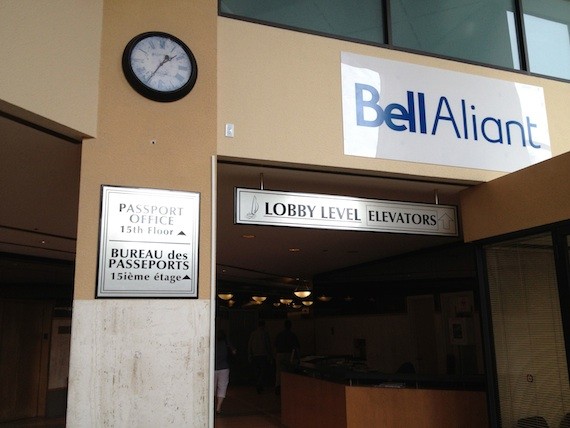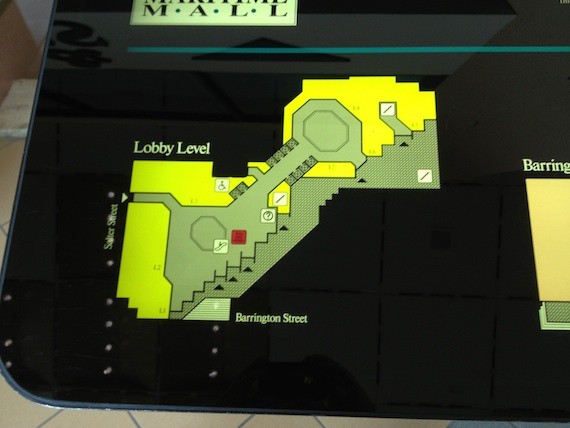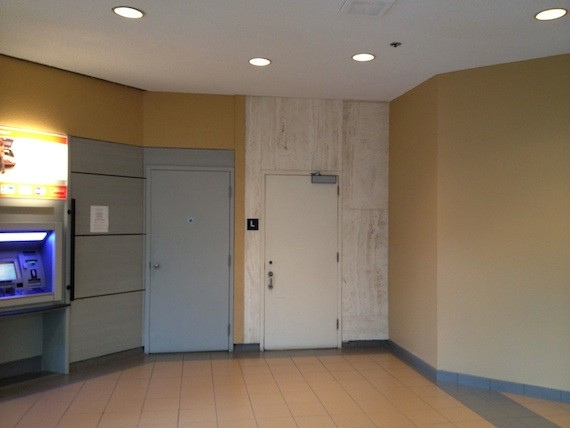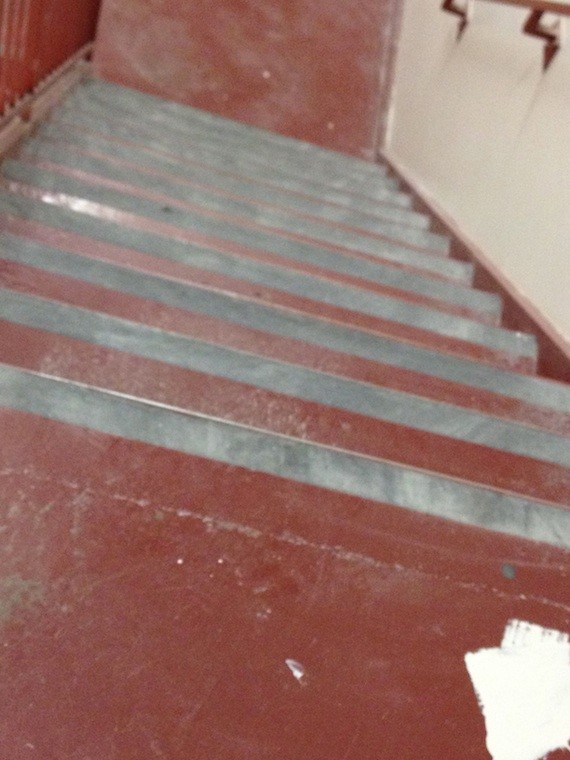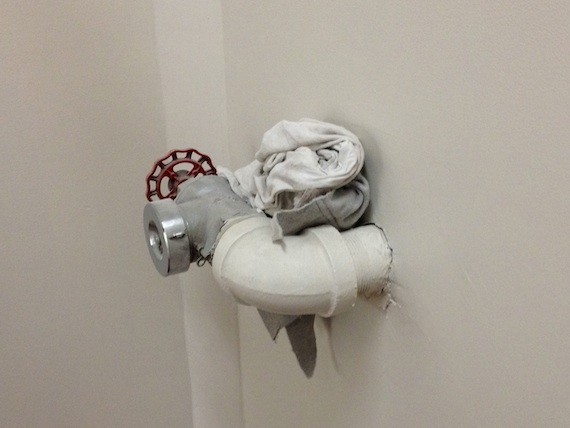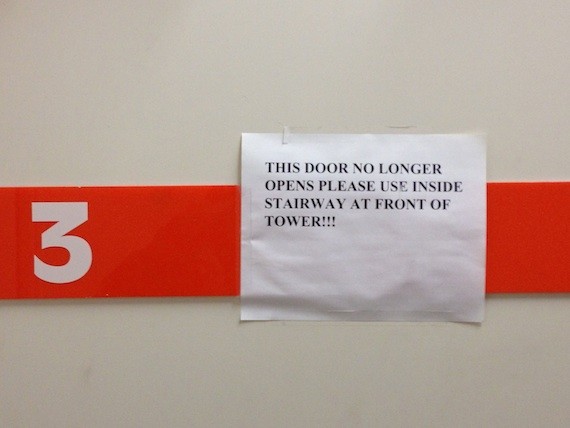But there's still one kind of active transportation infrastructure that doesn't even get lip service: stairways in buildings.
This has long been an irritant for me. I like to walk places, and I like to take the stairs. But more often than not, I can't even find the stairs, or if I can, they're nonfunctional.
Today I had business at the Maritime Centre on Barrington Street in downtown Halifax, so let me use that building as an example.
When I entered the building, there are clear, prominently displayed signs showing the way to the elevators:
But there are no prominent signs, or signs at all, for the stairs. The unstated assumption seems to be that no one, no one at all, would want to use the stairs, even to go to the second floor, so why give directions to them?
The Maritime Centre does, however, at least have stairways labeled on a map of the building found in the lobby:
I was heartened to find the map, as this is more than most buildings provide. I challenge you to find the stairway in the World Trade and Convention Centre building; I know there must be one, but I'll be damned if I can find it. I've been going to the law courts building on a fairly regular basis for six years, but I only discovered the stairway last month; I think I could find it again, but I'm not sure. The UARB is on the third floor of the old Daily News building on the waterfront—immensely within stair-climbing distance—but the entrance to the stairway from the ground floor is locked away behind another set of doors, or at least it was last week. My dentist is on the second floor of City Centre Atlantic, and I swear each and every time I go there I spend ten minutes walking around before I can find the stairway; I recall that several times I think I've found the stairs, only to be trying the wrong door.
Anyway, back at the Maritime Centre, my elation at finding the map of the building quickly turned to displeasure, as the stairs weren't where the map says they are, or if they are, there are too many impediments for a simpleton like me to find them. I walked towards the southern end of the building lobby, where the map seems to indicate there are stairs, only to repeatedly find doors leading out of the building, but none to stairways.
I went back to stare at the map some more, and a cleaning woman asked if she could help. I told her I was looking for the stairs, and she pointed behind us, "they're at every entrance." I looked where she was pointed, back at her, again followed her finger to where she was pointing. "I don't see any stairs," I said. "Oh, well, they're supposed to be around the doorways."
Just then I happened to see Bernie Smith in the Bell Aliant store, and so complained to him for a while about my inability to find the stairway. But coming out of the store, I stumbled upon this doorway, back behind a cash machine:
Besides the lone "L"—for "losers," perhaps—there's no indication that this is actually a stairway. No signs point wannabe climbers that direction, and there's nothing at all welcoming about the doorway.
Now, when it comes to the elevators, the Maritime Centre does things big. The elevator windows, which provide fantastic views of the harbour, are even a tourist destination, recommended to backpackers at Michelle Strum's hostel. And the rest of the building seems to be well-cared for, clean and in good repair. Except for the stairway. Besides consisting of nothing but blank concrete walls, the stairs are dirty and the paint is peeling:
And garbage is stuck in the exposed fire equipment:
The stairs are clearly the most neglected part of the entire building. How little thought is given to stairs? Consider, after climbing to the third floor, I find this sign on the door:
Let's think this through for a moment. First: what's the most iconic news story of stairways you can think of? For me, it's the hundreds of New York City firefighters who lost their lives on 9-11 while rushing up the stairways of the Word Trade Center in brave urgency to save others' lives. I wonder now, had the building not collapsed on them, if any of those firefighters would have come to locked doors. They certainly would if they had been in the Maritime Centre, and in many, many other buildings I've visited: I've found locked stairway doors all over town. Shouldn't our fire inspectors be concerned about this?
Second, what mean-spirited asshole put this sign on the third floor door instead of down at the lobby level, where it would save someone from pointlessly walking up, and then down, three flights of stairs? (It's three flights to the third floor because there's also a mezzanine level.)
Third, even at the lobby level, the sign would be hopelessly unhelpful, because whatever "inside stairway at the front of the tower" means isn't readily intelligible, not even with the help of the map in the lobby, so long as no directional signs are supplied.
I was tweeting about my frustrations as I walking around the Maritime Centre today, and some people who work in the building were tweeting back. Some said they didn't know where the stairs were, even after working there for years. One said his floor was told that the stairway was to be used only as a fire exit, and never for simply walking down to the lobby. Others said that the stairway doors at their floors were also locked.
I don't mean to pick on the Maritime Centre. It's no worse than most buildings. This is a societal wide problem: architects stick stairways in hard-to-find locations, and then make them as ugly as possible. Building managers neglect the stairways, and they become littered, with peeling paint, and often the lighting is horrible.
When stairways are treated like an inconvenience, an after-thought merely provided to meet fire codes, it's not a wonder that people aren't thinking about using them much. So everyone takes the elevator, even to the second or third floors, and loses out on a potentially easy, and cost-free, form of active transportation.
I don't think I'm asking for much: at a minimum, some proper directional signage, welcoming doorways, well-lit, clean and maintained interiors, doors that aren't locked. I'd be even happier if the stairways were jazzed up a bit; I can understand that maybe fire codes prohibit windows in stairways (but do they? I don't know), but surely some interesting painting schemes and murals are allowed.
My ultimate challenge, however, is to architects and planners: stop being the equivalent of 1970s city transportation planners, who put all their attention on highways and none on active transportation infrastructure. Elevators are the highways of building transportation, and have been getting all your attention for far too long. It's long past time to give the active transportation networks in your buildings, the stairways, the attention they deserve.

